
Gordon Paiʻea Chung-Hoon was an admiral in the United States Navy, who served during World War II and was the first Asian American flag officer. He received the Navy Cross and Silver Star for conspicuous gallantry and extraordinary heroism as commanding officer of USS Sigsbee from May 1944 to October 1945.

The Fletcher class was a class of destroyers built by the United States during World War II. The class was designed in 1939, as a result of dissatisfaction with the earlier destroyer leader types of the Porter and Somers classes. Some went on to serve during the Korean War and into the Vietnam War.

Presley O'Bannon was a first lieutenant in the United States Marine Corps, famous for his exploits in the First Barbary War (1801–1805). In recognition of his bravery, he was presented a sword for his part in attempting to restore Prince Hamet Karamanli to his throne as the Bey of Tripoli. This sword became the model for the Mameluke Sword, adopted in 1825 for Marine Corps officers, which is part of the formal uniform today.

USS Bush (DD-529), a Fletcher-class destroyer, was the second ship of the United States Navy to be named for Lieutenant William Sharp Bush, USMC, who served on the Constitution during the War of 1812.
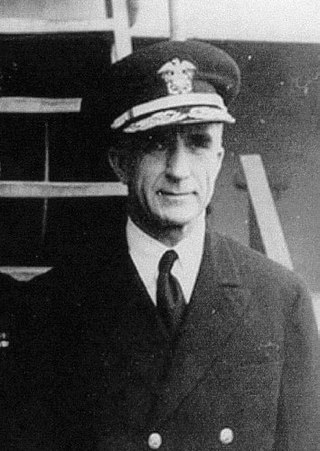
Vice Admiral Morton Lyndholm Deyo was an officer in the United States Navy, who was a naval gunfire support task force commander of World War II.

USS Mannert L. Abele (DD-733), was an Allen M. Sumner-class destroyer of the United States Navy. The destroyer was sunk on April 12, 1945, near Okinawa with 84 casualties. It was the first US warship to be damaged or sunk by the rocket powered Yokosuka MXY7 Ohka suicide flying bomb.

Robert Eugene Bush, at age 18, was the youngest member of the United States Navy in World War II to receive the nation's highest military decoration for valor, the Medal of Honor. He was awarded the medal for heroic actions "above and beyond the call of duty" while serving as hospital corpsman attached to a Marine Corps rifle company on May 2, 1945, during the Battle of Okinawa.

USS Epperson (DD/DDE-719) was a Gearing-class destroyer of the United States Navy. It was named for United States Marine Corps Private Harold G. Epperson (1923–1944) who was posthumously awarded the Medal of Honor for his heroism in the Battle of Saipan.
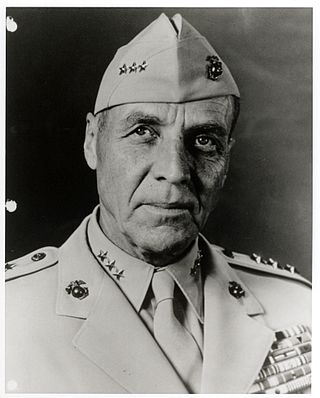
Lieutenant General Alan Shapley was a United States Marine Corps officer who survived the sinking of the USS Arizona during the World War II attack on Pearl Harbor, and went on to serve with distinction in the Pacific Theater and later in the Korean War. He was awarded the Silver Star for his gallantry on December 7, 1941, and later the Navy Cross for his extraordinary heroism during the Battle of Guam. His last command was as the commanding general of the Fleet Marine Force, Pacific.

John Walter Wilcox Jr. was a rear admiral of the United States Navy. He saw service in World War I and in the opening weeks of United States involvement in World War II before being lost overboard from his flagship in the North Atlantic Ocean in 1942.
Hispanics in the United States Navy can trace their tradition of naval military service to men such as Lieutenant Jordi Farragut Mesquida, who served in the American Revolution. Hispanics, such as Seaman Philip Bazaar and Seaman John Ortega, have distinguished themselves in combat and have been awarded the Medal of Honor, the highest military decoration of the United States. Hispanics have also reached the top ranks of the navy, serving their country in sensitive leadership positions on domestic and foreign shores. Among those who have reached the highest ranks in the navy are Commodore Uriah Phillips Levy, of Sephardic and Ashkenazic Jewish descent, who participated in the War of 1812 as an assistant Sailing master; Admiral David Glasgow Farragut, for whom the rank of admiral in the U.S. Navy was created during the American Civil War; and Admiral Horacio Rivero, who led the navy during the Cuban Missile Crisis.

USS Ringness (APD-100) was a Crosley-class high speed transport that served in the United States Navy from 1944 to 1946. After spending 29 years in reserve, she was sold for scrapping in 1975.

USS Pavlic (APD-70) was built by Dravo Corporation at Pittsburgh, Pennsylvania as a Buckley-class destroyer escort. Pavlic was launched 18 December 1943 and towed to Texas for refitting as a United States Navy high-speed transport. Pavlic was in commission from 1944 to 1946, serving in the Okinawa campaign as a radar picket ship. Pavlic was decommissioned 15 November 1946. After more than 20 years of inactivity in reserve, she was stricken from the Navy List on 1 April 1967. On 1 July 1968, she was sold for scrapping to North American Smelting Company.

Stuart Howe Ingersoll was a vice admiral of the United States Navy. He was a naval aviator whose career included service as an aircraft carrier commander during World War II and tours as commander-in-chief of the United States Seventh Fleet, President of the Naval War College, and Commandant of Midshipmen at the United States Naval Academy.
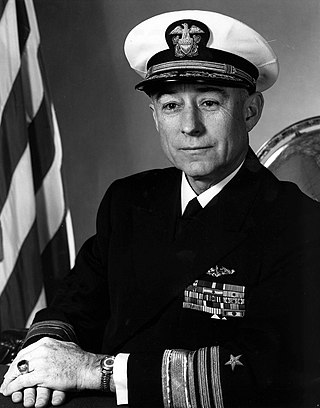
Bernard Lige Austin was a Vice Admiral of the United States Navy. His career included service in World War II, the Korean War, and the Cold War and command of submarines and surface ship forces, during which he became a distinguished combat commander of destroyers. He also commanded the United States Second Fleet, held numerous diplomatic, educational, and administrative staff positions, and a served a lengthy tour of duty as President of the Naval War College.

Charles Leroy Melson was a vice admiral of the United States Navy. His career included service in World War II, the Korean War, and the Cold War, command of the United States First Fleet and of the United States Taiwan Defense Command, and tours of duty as Superintendent of the United States Naval Academy and President of the Naval War College.

Benedict Joseph Semmes Jr. was a vice admiral of the United States Navy. His career included service in World War II and the Cold War, command of destroyers, a lengthy tour as Chief of Naval Personnel, command of the United States Second Fleet, duty as Deputy Chief of Naval Operations, and a tour as President of the Naval War College.
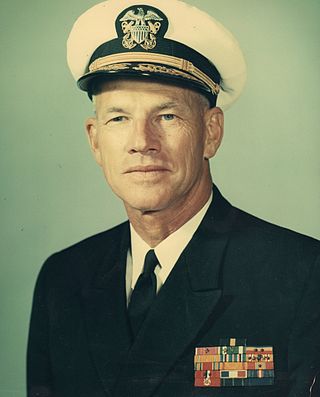
Lloyd Montague Mustin was a vice admiral in the United States Navy and among the namesakes of USS Mustin (DDG-89). He took part in developing the Navy's first lead-computing anti-aircraft gun sight, which proved of major importance in the air-sea actions of World War II, and he served on the cruiser USS Atlanta during the naval battle of Guadalcanal. His ship was lost during that action, and with other survivors he landed on Guadalcanal and served ashore with a naval unit attached to the First Marine Division. His postwar service included commands at sea and development and evaluation of weapon systems. He later served as director of operations for the Joint Chiefs of Staff during the Vietnam War.
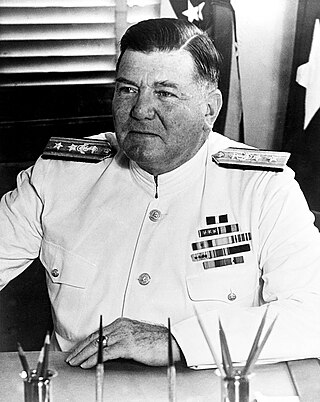
John Franklin Shafroth Jr. was a highly decorated officer in the United States Navy with the rank of Vice Admiral. He distinguished himself as Commander of destroyer USS Terry during World War I and received the Navy Cross, the United States Navy second-highest decoration awarded for valor in combat.

Thomas Ross Cooley was a decorated officer in the United States Navy with the rank of Vice Admiral. A veteran of two world wars, he distinguished himself as commanding officer of battleship USS Washington during Mariana Islands campaign and later as Commander, Battleship Division Six during the battles of Iwo Jima and Okinawa.


















